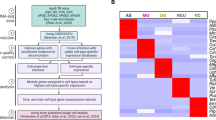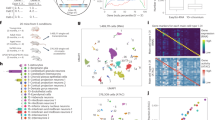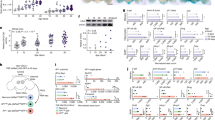Abstract
Senescent cells contribute to pathology and dysfunction in animal models1. Their sparse distribution and heterogenous phenotype have presented challenges to their detection in human tissues. We developed a senescence eigengene approach to identify these rare cells within large, diverse populations of postmortem human brain cells. Eigengenes are useful when no single gene reliably captures a phenotype, like senescence. They also help to reduce noise, which is important in large transcriptomic datasets where subtle signals from low-expressing genes can be lost. Each of our eigengenes detected ∼2% senescent cells from a population of ∼140,000 single nuclei derived from 76 postmortem human brains with various levels of Alzheimer’s disease (AD) pathology. More than 97% of the senescent cells were excitatory neurons and overlapped with neurons containing neurofibrillary tangle (NFT) tau pathology. Cyclin-dependent kinase inhibitor 2D (CDKN2D/p19) was predicted as the most significant contributor to the primary senescence eigengene. RNAscope and immunofluorescence confirmed its elevated expression in AD brain tissue. The p19-expressing neuron population had 1.8-fold larger nuclei and significantly more cells with lipofuscin than p19-negative neurons. These hallmark senescence phenotypes were further elevated in the presence of NFTs. Collectively, CDKN2D/p19-expressing neurons with NFTs represent a unique cellular population in human AD with a senescence-like phenotype. The eigengenes developed may be useful in future senescence profiling studies as they identified senescent cells accurately in snRNA-Seq datasets and predicted biomarkers for histological investigation.
This is a preview of subscription content, access via your institution
Access options
Access Nature and 54 other Nature Portfolio journals
Get Nature+, our best-value online-access subscription
$29.99 / 30 days
cancel any time
Subscribe to this journal
Receive 12 digital issues and online access to articles
$119.00 per year
only $9.92 per issue
Buy this article
- Purchase on SpringerLink
- Instant access to full article PDF
Prices may be subject to local taxes which are calculated during checkout




Similar content being viewed by others
Data availability
The snRNA-Seq data analyzed in this study are available from https://www.synapse.org/ with synapse IDs: syn18485175 and syn21126462 for cohorts 1 and 2, respectively. Accessing these data requires submitting a Data Use Certificate through the AMP–AD website. Clinical data were available in the corresponding publications. The scRNA-Seq data from the embryonic cortex and the scRNA-Seq data from the entorhinal cortex are also available from the Gene Expression Omnibus54 with accession numbers GSE103723 and GSE138852.
Code availability
Our R scripts, which are available as Supplementary material, can be used to fully reproduce our results. Our code is also publicly available at https://bitbucket.org/habilzare/alzheimer/src/master/code/senescence/Shiva/.
Change history
16 December 2021
In the version of this article initially appearing online, the Supplementary Code file was missing, and has been included as of 16 December 2021.
References
González-Gualda, E., Baker, A. G., Fruk, L. & Muñoz-Espín, D. A guide to assessing cellular senescence in vitro and in vivo. FEBS J. 288, 56–80 (2020).
Acosta, J. C. et al. A complex secretory program orchestrated by the inflammasome controls paracrine senescence. Nat. Cell Biol. 15, 978–990 (2013).
Musi, N. et al. Tau protein aggregation is associated with cellular senescence in the brain. Aging Cell 17, e12840 (2018).
Chow, H. M. et al. Age-related hyperinsulinemia leads to insulin resistance in neurons and cell-cycle-induced senescence. Nat. Neurosci. 22, 1806–1819 (2019).
Ogrodnik, M. et al. Obesity-induced cellular senescence drives anxiety and impairs neurogenesis. Cell Metab. 29, 1061–1077 e1068 (2019).
Riessland, M. et al. Loss of SATB1 induces p21-dependent cellular senescence in post-mitotic dopaminergic neurons. Cell Stem Cell 25, 514–530 e518 (2019).
Chinta, S. J. et al. Cellular senescence is induced by the environmental neurotoxin paraquat and contributes to neuropathology linked to Parkinson’s disease. Cell Rep. 22, 930–940 (2018).
Bussian, T. J. et al. Clearance of senescent glial cells prevents tau-dependent pathology and cognitive decline. Nature 562, 578–582 (2018).
Zhang, P. et al. Senolytic therapy alleviates Aβ-associated oligodendrocyte progenitor cell senescence and cognitive deficits in an Alzheimer’s disease model. Nat. Neurosci. 22, 719–728 (2019).
Justice, J. N. et al. Cellular senescence biomarker p16INK4a+ cell burden in thigh adipose is associated with poor physical function in older women. J. Gerontol. A Biol. Sci. Med. Sci. 73, 939–945 (2018).
Hickson, L. J. et al. Senolytics decrease senescent cells in humans: preliminary report from a clinical trial of Dasatinib plus Quercetin in individuals with diabetic kidney disease. EBioMedicine 47, 446–456 (2019).
Gillispie, G. J. Evidence of the cellular senescence stress response in mitotically active brain cells – implications for cancer and neurodegeneration.Life (Basel) 11, 153 (2021).
Sah, E. The cellular senescence stress response in post-mitotic brain cells – cell survival at the expense of tissue degeneration. Life (Basel) 11, 229 (2021).
Arendt, T., Rodel, L., Gartner, U. & Holzer, M. Expression of the cyclin-dependent kinase inhibitor p16 in Alzheimer’s disease. Neuroreport 7, 3047–3049 (1996).
Katsouri, L. et al. Ablation of reactive astrocytes exacerbates disease pathology in a model of Alzheimer’s disease. Glia 68, 1017–1030 (2020).
Hansen, D. V., Hanson, J. E. & Sheng, M. Microglia in Alzheimer’s disease. J. Cell Biol. 217, 459–472 (2018).
Oldham, M. C., Horvath, S. & Geschwind, D. H. Conservation and evolution of gene coexpression networks in human and chimpanzee brains. Proc. Natl Acad. Sci. USA 103, 17973–17978 (2006).
Foroushani, A. et al. Large-scale gene network analysis reveals the significance of extracellular matrix pathway and homeobox genes in acute myeloid leukemia: an introduction to the Pigengene package and its applications. BMC Med. Genomics 10, 16 (2017).
Mathys, H. et al. Single-cell transcriptomic analysis of Alzheimer’s disease. Nature 570, 332–337 (2019).
Zhou, Y. et al. Human and mouse single-nucleus transcriptomics reveal TREM2-dependent and TREM2-independent cellular responses in Alzheimer’s disease. Nat. Med. 26, 131–142 (2020).
Fan, X. et al. Spatial transcriptomic survey of human embryonic cerebral cortex by single-cell RNA-seq analysis. Cell Res. 28, 730–745 (2018).
Bryant, A. G. et al. Cerebrovascular senescence is associated with tau pathology in Alzheimer’s disease. Front. Neurol. 11, 575953 (2020).
Bhat, R. et al. Astrocyte senescence as a component of Alzheimer’s disease. PLoS ONE 7, e45069 (2012).
Tchkonia, T. & Kirkland, J. L. Aging, cell senescence, and chronic disease: emerging therapeutic strategies. JAMA 320, 1319–1320 (2018).
Hooper, A. T. et al. Angiomodulin is a specific marker of vasculature and regulates vascular endothelial growth factor-A-dependent neoangiogenesis. Circ. Res. 105, 201–208 (2009).
Boraas, L. C. & Ahsan, T. Lack of vimentin impairs endothelial differentiation of embryonic stem cells. Sci. Rep. 6, 30814 (2016).
Grubman, A. et al. A single-cell atlas of entorhinal cortex from individuals with Alzheimer’s disease reveals cell-type-specific gene expression regulation. Nat. Neurosci. 22, 2087–2097 (2019).
Avelar, R. A. et al. A multidimensional systems biology analysis of cellular senescence in aging and disease. Genome Biol. 21, 91 (2020).
Ashburner, M. et al. Gene ontology: tool for the unification of biology. The Gene Ontology Consortium. Nat. Genet. 25, 25–29 (2000).
Gene Ontology, C. The Gene Ontology resource: enriching a GOld mine. Nucleic Acids Res. 49, D325–D334 (2021).
Kanehisa, M. & Goto, S. KEGG: Kyoto encyclopedia of genes and genomes. Nucleic Acids Res. 28, 27–30 (2000).
Orr, M. E., Sullivan, A. C. & Frost, B. A brief overview of tauopathy: causes, consequences, and therapeutic strategies. Trends Pharmacol. Sci. 38, 637–648 (2017).
Fu, H. et al. A tau homeostasis signature is linked with the cellular and regional vulnerability of excitatory neurons to tau pathology. Nat. Neurosci. 22, 47–56 (2019).
Dunckley, T. et al. Gene expression correlates of neurofibrillary tangles in Alzheimer’s disease. Neurobiol. Aging 27, 1359–1371 (2006).
Otero-Garcia, T. et al. Single-soma transcriptomics of tangle-bearing neurons in Alzheimer’s disease reveals the signatures of tau-associated synaptic dysfunction. Preprint at bioRxiv https://doi.org/10.1101/2020.05.11.088591 (2020).
Furcila, D., Dominguez-Alvaro, M., DeFelipe, J. & Alonso-Nanclares, L. Subregional density of neurons, neurofibrillary tangles and amyloid plaques in the hippocampus of patients with Alzheimer’s disease. Front. Neuroanat. 13, 99 (2019).
Neurohr, G. E. et al. Excessive cell growth causes cytoplasm dilution and contributes to senescence. Cell 176, 1083–1097.e1018 (2019).
Georgakopoulou, E. A. et al. Specific lipofuscin staining as a novel biomarker to detect replicative and stress-induced senescence. A method applicable in cryo-preserved and archival tissues. Aging (Albany NY) 5, 37–50 (2013).
Frost, B., Bardai, F. H. & Feany, M. B. Lamin dysfunction mediates neurodegeneration in tauopathies. Curr. Biol. 26, 129–136 (2016).
Barascu, A. et al. Oxidative stress induces an ATM-independent senescence pathway through p38 MAPK-mediated lamin B1 accumulation. EMBO J. 31, 1080–1094 (2012).
Hodes, R. J. & Buckholtz, N. Accelerating medicines partnership: Alzheimer’s disease (AMP–AD) knowledge portal aids Alzheimer’s drug discovery through open data sharing. Expert Opin. Ther. Targets 20, 389–391 (2016).
Bennett, D. A. et al. Religious orders study and rush memory and aging project. J. Alzheimers Dis. 64, S161–S189 (2018).
R Core Team. R.: A language and environment for statistical computing https://www.R-project.org/ (2013).
R Core Team. R: a language and environment for statistical computing. (R Foundation for Statistical Computing, 2017).
Zainulabadeen, A., Yao, P. & Zare, H. Underexpression of specific interferon genes is associated with poor prognosis of melanoma. PLoS ONE 12, e0170025 (2017).
Agrahari, R. et al. Applications of Bayesian network models in predicting types of hematological malignancies. Sci. Rep. 8, 6951 (2018).
Samimi, H. DNA methylation analysis improves the prognostication of acute myeloid leukemia. eJHaem 2, 211–218 (2021).
Butler, A., Hoffman, P., Smibert, P., Papalexi, E. & Satija, R. Integrating single-cell transcriptomic data across different conditions, technologies, and species. Nat. Biotechnol. 36, 411–420 (2018).
Hafemeister, C. & Satija, R. Normalization and variance stabilization of single-cell RNA-seq data using regularized negative binomial regression. Genome Biol. 20, 296 (2019).
Altman, N. S. An introduction to kernel and nearest-neighbor nonparametric regression. Am. Stat. 46, 175–185 (1992).
Blondel, V. D., Guillaume, J.-L., Lambiotte, R. & Lefebvre, E. Fast unfolding of communities in large networks. J. Stat. Mech. 2008, P10008 (2008).
McInnes, L., Healy, J. & Melville, J. Umap: Uniform manifold approximation and projection for dimension reduction. Preprint at arXiv (2018).
Merritt, C. R. et al. Multiplex digital spatial profiling of proteins and RNA in fixed tissue. Nat. Biotechnol. 38, 586–599 (2020).
Edgar, R., Domrachev, M. & Lash, A. E. Gene Expression Omnibus: NCBI gene expression and hybridization array data repository. Nucleic Acids Res. 30, 207–210 (2002).
Acknowledgements
This work is supported by NIH/NIA (R01AG068293, R01AG057896, U01AG046170, RF1AG057440, R01AG057907, K99AG061259; P30AG062421; RF1AG051485, R21AG059176, and RF1AG059082 and T32AG021890), Cure Alzheimer’s Fund, New Vision Research Charleston Conference for Alzheimer’s Disease, and Veterans Affairs (IK2BX003804). We obtained ROSMAP data from the AD Knowledge Portal (https://adknowledgeportal.synapse.org). Study data were provided by the Rush Alzheimer’s Disease Center, Rush University Medical Center, Chicago. Data generation was supported by National Institute on Aging (NIA) and grants RF1AG57473, P30AG10161, R01AG15819, R01AG17917, U01G46152, U01AG61356 and RF1AG059082. Additional phenotypic ROSMAP data can be requested at https://www.radc.rush.edu. We acknowledge the Texas Advanced Computing Center (TACC) at the University of Texas at Austin for providing high-performance computing resources: http://www.tacc.utexas.edu. We acknowledge the Biggs Institute Brain Bank and Massachusetts ADRC for providing postmortem human tissue for analyses. The funders had no role in study design, data collection and analysis, decision to publish or preparation of the manuscript.
Author information
Authors and Affiliations
Contributions
All authors edited and approved the final manuscript. In addition, S.K.D. developed code, designed and performed in silico experiments, performed all bioinformatic and statistical analyses, prepared figures and drafted the manuscript; J.W. provided tissue from the Biggs Brain Bank, performed p19 and AT8 IHC validation and wrote IHC methods; E.S. performed immunofluorescence validation (p19, AT8 and lamin B1), performed confocal microscopy and wrote the corresponding methods; E.B. performed blinded analyses of IHC and immunofluorescence and wrote the corresponding methods; F.A. performed immunofluorescence (p19, AT8 and Map2) validation and wrote corresponding methods; B.F. provided oversight to F.A. and provided Lamin b1 expertise; B.W. performed RNAScope; R.E.B. requested and acquired brain tissue from MGH ADRC, performed confocal microscopy, provided oversight to B.W., generated RNAscope figures and wrote RNAscope methods, RNAscope data interpretation; T.C.O. developed methods to analyze lamin b1 expression, performed blinded lamin b1 analyses and wrote lamin B1 analyses methods; Y.Z. provided access and expertise on cohort 2 snRNA-Seq data; P.S.A. provided access and expertise on cohort 2 snRNA-Seq data; M.C. provided access and expertise on cohort 2 snRNA-Seq data; P.H.S. provided bioinformatics consultation and validation; P.X. performed cell clustering analyses and wrote corresponding methods; M.W. performed cell clustering analyses and wrote the corresponding methods; B.Z. provided oversight to P.X. and provided bioinformatic consultation; H.Z. provided oversight to S.K.D. (bioinformatic experimental design and development), acquired access to all datasets, designed and confirmed bioinformatic data analyses and interpreted results; M.E.O. conceived the project, acquired funding, provided supervision (E.S., E.B. and T.C.O.), analyzed and interpreted histology data, interpreted bioinformatic data, and drafted manuscript and submitted the manuscript.
Corresponding authors
Ethics declarations
Competing interests
Patent applicant: Wake Forest University Health Sciences. Name of inventor: Miranda Orr. Application number: 63/199,927 & 63/261,630. Status of application: Pending. The specific aspect of manuscript covered in patent application: data from this manuscript was used to file a patent, ‘Biosignature and therapeutic approach for neuronal senescence’.
Additional information
Peer review information Nature Aging thanks Markus Riessland and the other, anonymous, reviewer(s) for their contribution to the peer review of this work.
Publisher’s note Springer Nature remains neutral with regard to jurisdictional claims in published maps and institutional affiliations.
Extended data figures and tables
Extended Data Fig. 1 Prominent senescent cell types in prefrontal cortex of the embryonic control.
Cell types and counts represented in the senescent cell population discovered in (A) CSP, (B) SIP and (C) SRP. The cutoff and statistical test definitions are the same as in Fig. 1. Cell populations: astrocytes [Ast], blood cells [Blood], Cajal-Retzius cells [Cajal], endothelial cells [Endo], excitatory neurons [Ext], immune cells [Immune], inhibitory neuron [Inh], microglia [Micro], neural stem cells [NSC], and oligodendrocyte precursor cells [Oligo] were classified in the original publication.
Extended Data Fig. 2 Prominent senescent cell types in the dorsal lateral prefrontal cortex in Cohort 2.
Cell types and counts represented in the senescent cell population discovered in (A) CSP, (B) SIP and (C) SRP with n = 57,857. The cutoff, statistical test and abbreviations definitions are the same as in Fig. 1.
Extended Data Fig. 3 Overlap between senescent and NFT neurons.
Each vertical bar represents the number of neurons in Cohort 1 that express the eigengenes marked by green circles below the bar. Each row at the bottom corresponds to an eigengene, and the number of neurons expressing that eigengene is shown in the right end on each row. The probability distributions of multi-set intersections have been calculated and the significance was tested using a hypergeometric test. The scale bar at top right shows the level of significance for each intersection. The largest p-value is −232 in log10 scale, which corresponds to the intersection between SRP and CSP expressing cells.
Extended Data Fig. 4 Prominent senescent cell types using CellAge, GO and KEGG gene lists in Cohort 1.
Cell types and counts represented in the senescent cell population discovered in (A) CellAge, (B) GO and (C) KEGG. The cutoff, statistical test and abbreviations definitions are the same as in Fig. 1.
Extended Data Fig. 5 Overlap between senescent cell populations.
Each vertical bar represents the number of senescent cells in Cohort 1 that express the senescence eigengenes, marked by green circles below the bar. Each row at the bottom corresponds to a senescence eigengene, and the number of senescent cells expressing that eigengene is shown at the end of each row. The probability distributions of multi-set intersections have been calculated and the significance was tested using a hypergeometric test. The scale bar at top right shows the level of significance for each intersection. The largest p-value is-260 in log10 scale corresponding to the intersection of SRP and CSP.
Extended Data Fig. 6 Excitatory neurons are the prominent senescent cell types based on CDKN2D in (A) Cohort 1 and (B) Cohort 2.
Cell types and counts represented in the senescent cell population using only CDKN2D. The cutoff, statistical tests and abbreviations definitions are the same as in Fig. 1.
Extended Data Fig. 7 RNAscope reveals higher CDKN2D expression in postmortem brains from cases with AD than age-matched control brains.
A. CDKN2D negative and positive control probe signal. B. CDKN2D RNAscope on three separate AD cases (n = 3) compared to a representative age-matched non-demented control (n = 3) (refer to Supplementary Table 5 for case characteristics. Scale bar 50 μm.
Extended Data Fig. 8 CDKN2D RNAscope co-localized with neuronal marker, HuD.
Postmortem AD tissue was processed for RNAscope with CDKN2D (green) and co-labeled for total nuclei (DAPI, gray) and neurons (HuD, cyan)/ Merged image display strong overlap between CDKN2D and neurons, but not other cell types (that is, blue and green co-localization with infrequent green co-localization in nuclei without HuD staining). Scale bar 10 μm. Representative images from postmortem human brains (n = 3 control and n = 3 AD cases).
Supplementary information
Supplementary Table 1
This file contains Supplemental Tables 1-3 combined into a single excel workbook file with multiple Tabs. Supplementary Table 1 contains the gene lists used to create each of the eigengene; Supplementary Table 2 (multiple tabs) contains eigengene expression data from every cell analyzed across datasets. Supplementary Table 3 (multiple tabs) contains data describing the overlap between cells expressing the senescence eigengenes and those expressing the NFT eigengenes for both cohorts (1 and 2) using both NFT eigengenes (Dunckley and Garcia).
Rights and permissions
About this article
Cite this article
Dehkordi, S.K., Walker, J., Sah, E. et al. Profiling senescent cells in human brains reveals neurons with CDKN2D/p19 and tau neuropathology. Nat Aging 1, 1107–1116 (2021). https://doi.org/10.1038/s43587-021-00142-3
Received:
Accepted:
Published:
Issue Date:
DOI: https://doi.org/10.1038/s43587-021-00142-3



